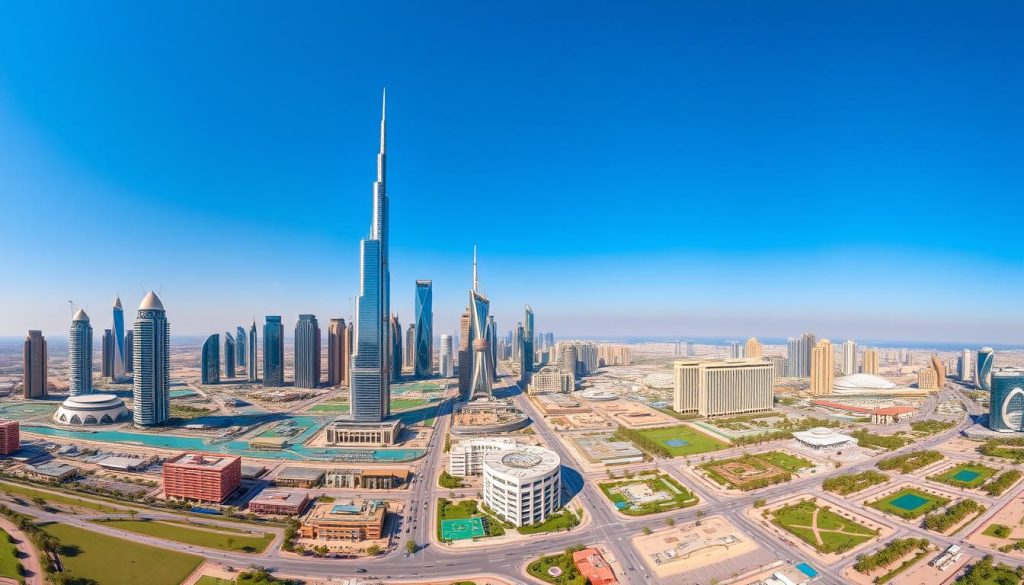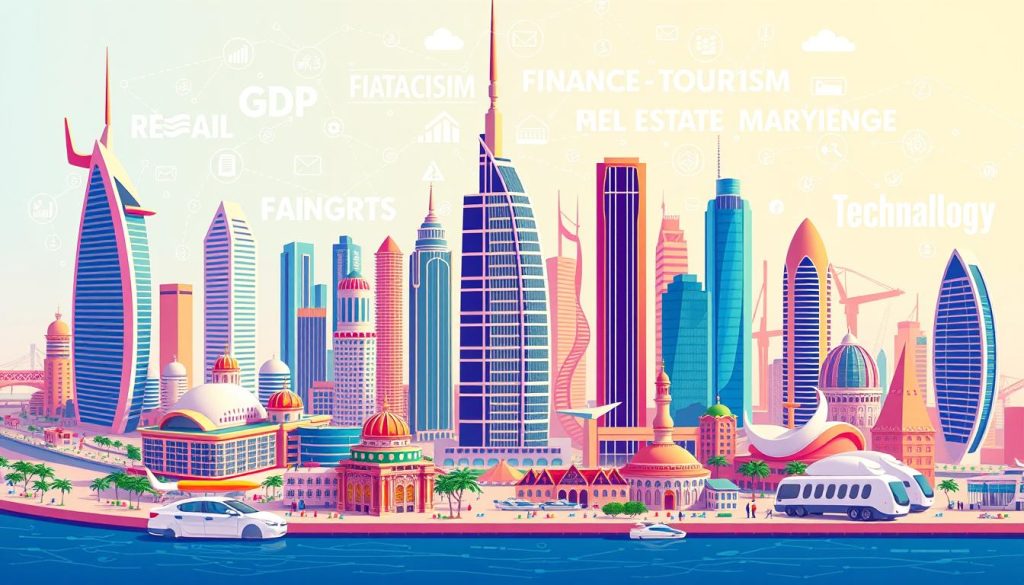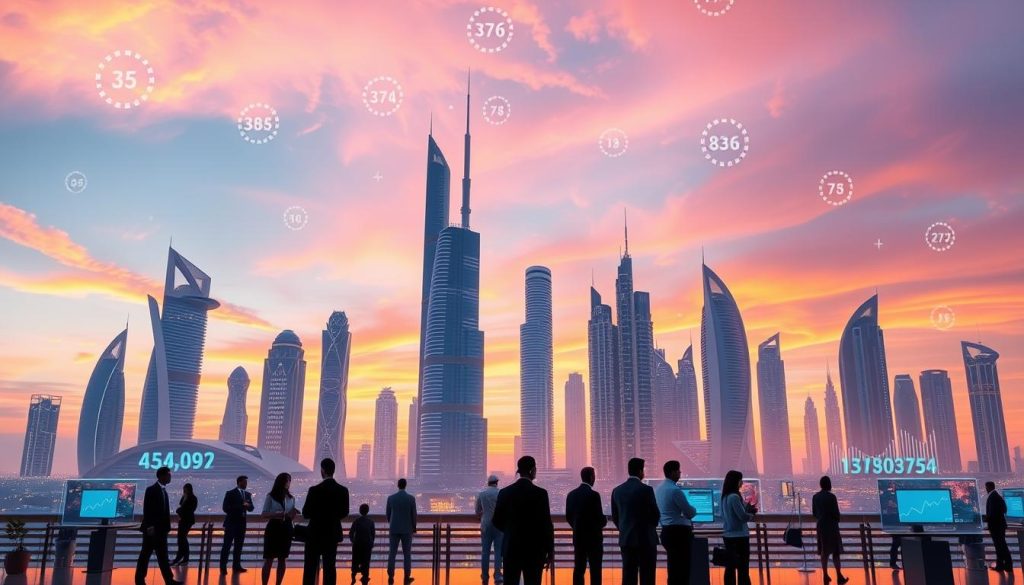The structural business statistics in Dubai give us key insights into its economy. The Dubai Data and Statistics Establishment was set up under Law No. (24) of 2023. This move strengthens data collection and sharing, vital for grasping the Dubai economy.
This effort aligns with Federal Law Decree No. (45) of 2021. It improves the quality of *UAE business statistics*. This helps in making better decisions and boosts competitiveness.
Through the Dubai Data and Statistics Establishment, we get access to detailed statistics and reports. These show the changes happening in different sectors. The establishment uses surveys to gather data from specific groups, ensuring accuracy.
Looking at recent data on businesses and sector performance, we find important trends. These trends highlight Dubai’s economic strength and its move towards diversification.
Overview of Dubai’s Economic Growth
Dubai is moving away from oil dependence, aiming for a diverse economy. We want to double our GDP to AED 3 trillion by 2031. In 2023, our GDP was AED 429 billion, showing strong growth thanks to new plans.
Investments in public infrastructure boost growth in non-oil sectors. We aim for AED 800 billion in non-oil exports. Tourism, finance, and tech are key areas for growth, with wholesale and retail trade making up 26% of GDP in 2018.
Despite regional conflicts and oil price changes, we’re expecting 4% GDP growth in 2024. This shows Dubai’s resilience and commitment to diversification. We aim to stay a leading trade and logistics centre globally.

Sector Contributions to GDP
Dubai’s economy is diverse, thanks to various sectors. These sectors show how Dubai has grown and changed. The focus on oil diversification has helped the economy move beyond oil.
Key Economic Sectors in Dubai
It’s important to know the main sectors driving Dubai’s economy. Here are a few:
- Wholesale and retail trade: This sector is huge, making up 22.9% of the GDP, worth AED 26.3 billion.
- Transportation and storage: It grew by 5.6%, making up 13.4% of the GDP, adding AED 15.4 billion.
- Financial and insurance activities: This sector is worth 13.1% of the economy, growing by 5.6% to AED 15.1 billion.
- Real estate activities: It’s 7.3% of Dubai’s GDP, making AED 8.4 billion, with a 3.7% growth.
- Manufacturing: It’s a key part of Dubai’s economy.
Shift from Oil Reliance to Diversification
Dubai has moved from relying on oil to a more diverse economy. Oil used to make up over 50% of the GDP. Now, non-oil sectors make up about 73% of the GDP. This change shows Dubai’s ability to adapt and modernize, focusing on tourism, real estate, and innovation.

Structural Business Statistics in Dubai
The business scene in Dubai is growing fast. Over 106,000 companies are now registered here. Small and medium enterprises make up about 95% of these.
This shows how vital SMEs are to our economy. They play a big role in our business world.
The D33 Economic Agenda shows Dubai’s aim to boost innovation and attract foreign investment. This plan makes Dubai a top economic spot in the area. It also makes the business scene more competitive.
The Dubai International Financial Centre (DIFC) has made changes to its rules. Now, more companies can set up there. This includes GCC-owned firms and those with GCC assets.
The Role of SMEs in Dubai’s Economy
SMEs in Dubai are the heart of our economy, making up 95% of all businesses. They are key in bringing new ideas and entrepreneurial spirit to the area. By 2040, they are set to make up 40% of Dubai’s income.
Our government knows how important SMEs are. So, they keep working on plans to help them grow and stay strong.
Percentage of SMEs in the Business Population
In Dubai, SMEs are a big deal, with 72% being micro-enterprises, 18% small, and 5% medium. This shows how diverse and wide-ranging the SME sector is. They play a big part in our market, employing about 42% of the workforce.
SMEs Contribution to GDP and Employment
SMEs in Dubai have a big impact, especially in certain areas. They make up 30% of the trade sector’s GDP, 57% of the services sector, and 14% of manufacturing. These numbers show how they help our economy grow.
Medium-sized SMEs are especially productive, with an average of AED 244,785 per employee. This is much higher than micro-enterprises, which average AED 91,080. This shows the potential for growth and innovation in our SMEs.
Key Economic Drivers in Dubai
Dubai’s economy is driven by several key sectors. Tourism is a big player, bringing in lots of money and creating jobs. Real estate shows our city’s growth and development plans.
Tourism as a Revenue Source
Tourism has grown a lot in Dubai. In 2022, we had 14.36 million visitors. They added nearly $41 billion to our GDP and supported 570,000 jobs. This growth matches our efforts to make Dubai a top tourist spot.
Real Estate and Construction Trends
The real estate market shows Dubai’s big dreams. We have landmarks like the Burj Khalifa and Dubai Mall. With a 4% GDP growth forecast for 2024, construction is set to grow even more.
Investments in tourism and technology will help. With steady tender price inflation, we expect strong real estate trends. This will keep attracting foreign investors, making Dubai a global leader.

